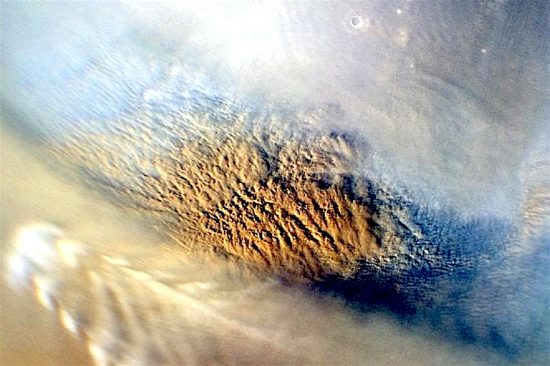
Gigantic dust storm on Mars. Note the numerous filamentary funnels. Credit: NASA/JPL-Caltech/MSSS. Click to enlarge.
Aug 14, 2017
What drives anomalous formations on planets and moons?
Plumes of charged plasmas are seen ascending from several bodies in the Solar System. Jupiter’s energetic moon, Io, hosts filamentary discharges that extend hundreds of kilometers into space. The Cassini mission to Saturn discovered bursts of ionized vapor erupting from the south pole of Enceladus. Whorls of dust, or “dust devils”, imaged by rovers on the Martian surface, were discussed in previous Pictures of the Day.
Some of those formations are higher than Mt. Everest, appearing to draw surface dust up through thousands of funnels, carrying it for hundreds of kilometers. In such disparate environments, a common factor for those phenomena is most likely electrical in nature.
For example, massive dust storms sometimes engulf an entire hemisphere on Mars. Synchrotron radiation is detected at the tops and bottoms of the tornado-like whirlwinds that aggregate into structures that can encompass tens of thousands of square kilometers. NASA planetary scientists assume that the glow is caused by electric charge build-up in the sand grains.
Cameras in space, as well as on the Martian surface, recorded large, glowing funnels raking across the flatlands, leaving darkened trackways behind. Since the atmospheric density on Mars is less than one percent that of Earth, how can wind carve the soil and leave multiple tracks that can be seen from space?
Using the formula q=0.5ρv2, where q is the pressure, ρ is the density of the atmosphere and v is the wind velocity, the dynamic pressure of a 97 kilometer per hour wind on Mars is equivalent to that from a 12 kilometer per hour wind on Earth. Even the most intense winds on Mars exert a small fraction of the force that is experienced here. So, what energizes the global dust storms in such a rarified vapor of frigid carbon dioxide gas?
Dust devil formation on Earth is conventionally described as a vortex of warm air that begins as a horizontal “rotator” near the ground. When the spinning air gains momentum, it “stands up”, forming a cylindrical cloud of dust that twists its way over the surface. As it increases in strength, it tightens its diameter like an ice skater doing a pirouette, gradually contracting while spinning faster.
On Mars there is no compact vortex of dense, spinning air to form a dust devil. Yet, as mentioned, some of the funnels climb thousands of meters into the sky.
Years ago, atmospheric scientists claimed that “saltation” generated the electric fields that were discovered in the dust devils of Arizona. Saltation means “the intermittent, leaping movement of sand and gravel particles from the force of wind or running water”. In other words, sand particles are supposed to create electric charges close to 10,000 volts per meter by rubbing against each other.
In an Electric Universe, no collisions from bouncing sand grains are necessary. Charge separation already exists in the atmosphere. Without clouds like those on Earth to send lightning down to ground level, the electric discharges on Mars form giant whirlwinds that are part of an interplanetary electric circuit. It is the kind of circuit that drives weather systems on Earth. If that is true, then Martian “dust devils” and those on Earth are both illustrations of how electricity behaves in the Solar System.
Stephen Smith












